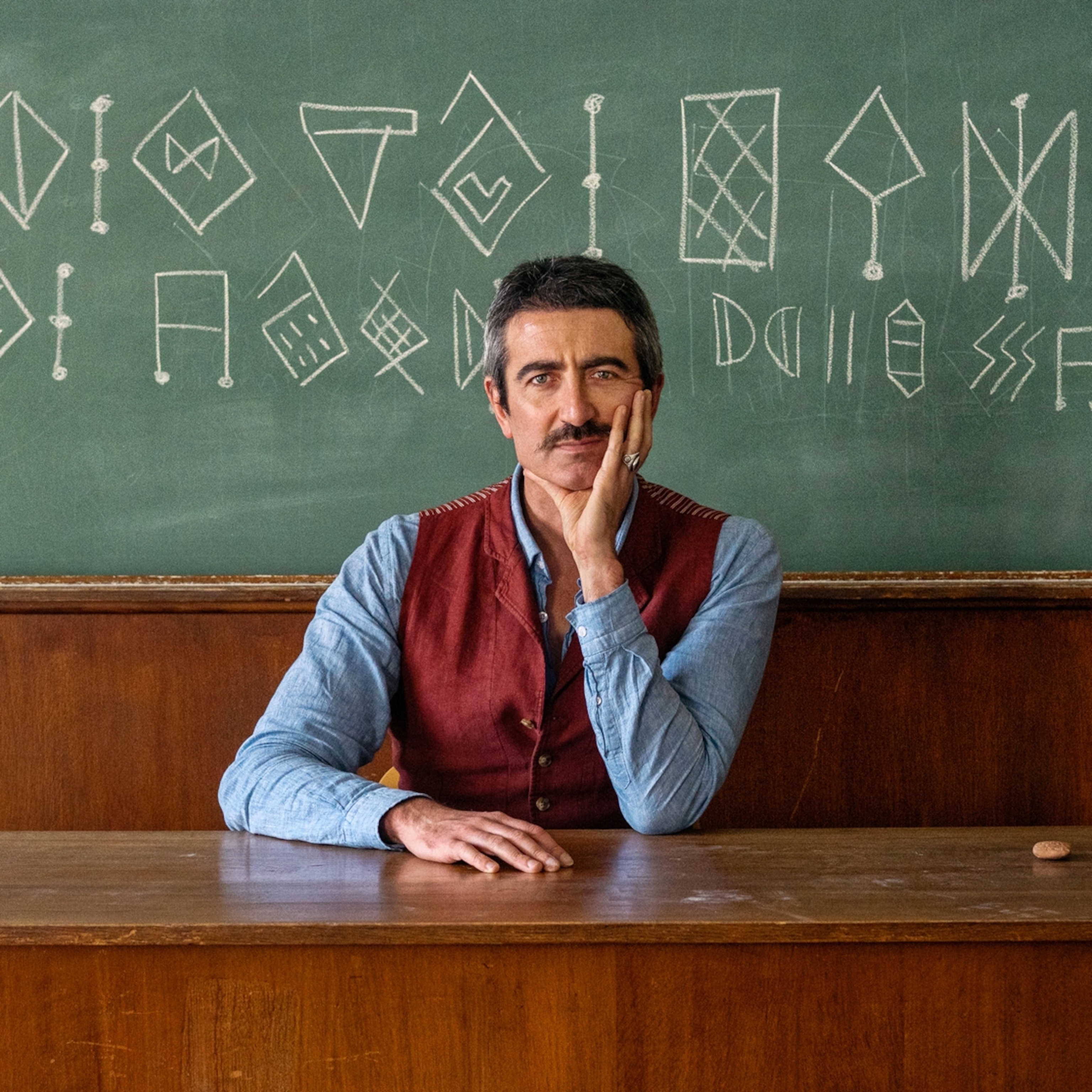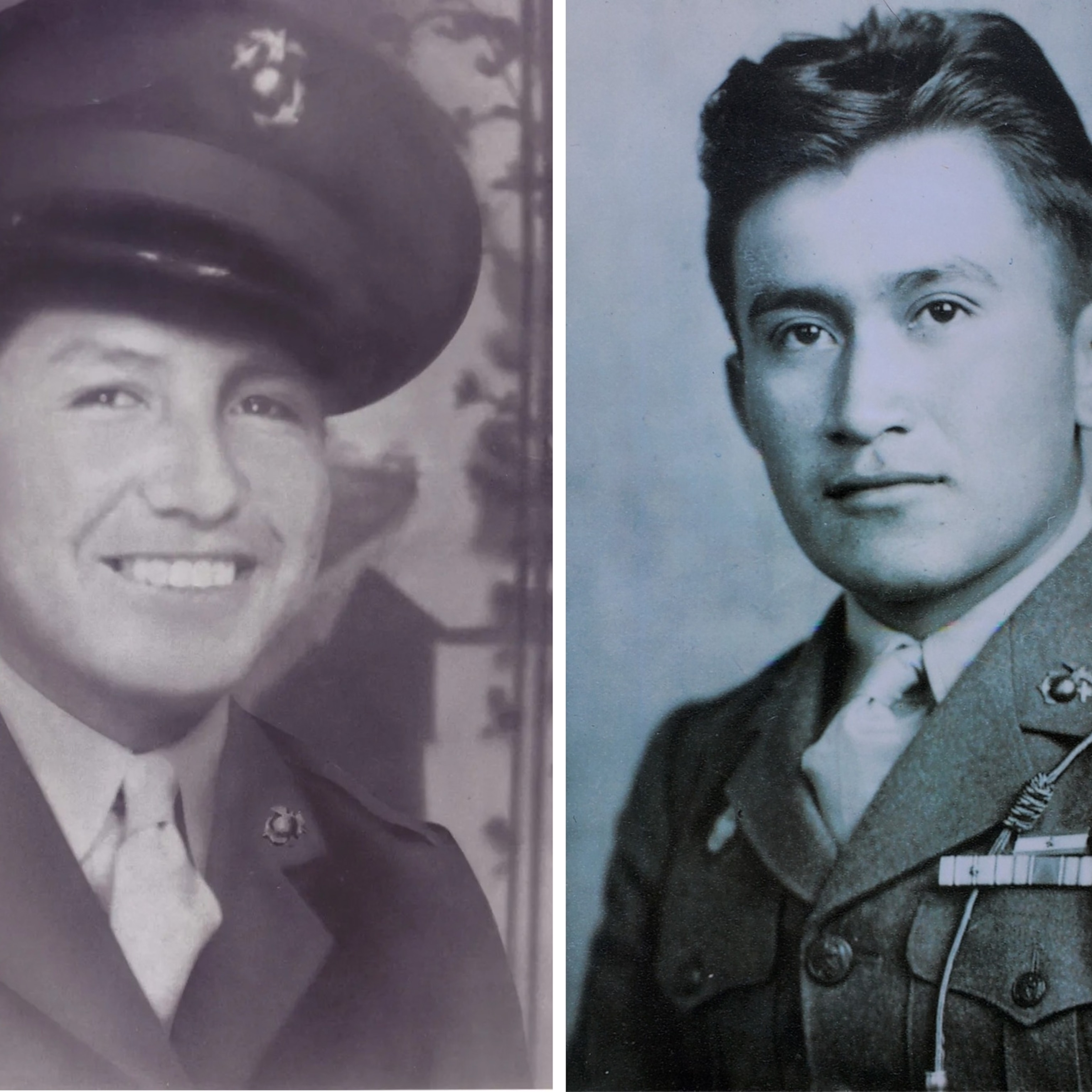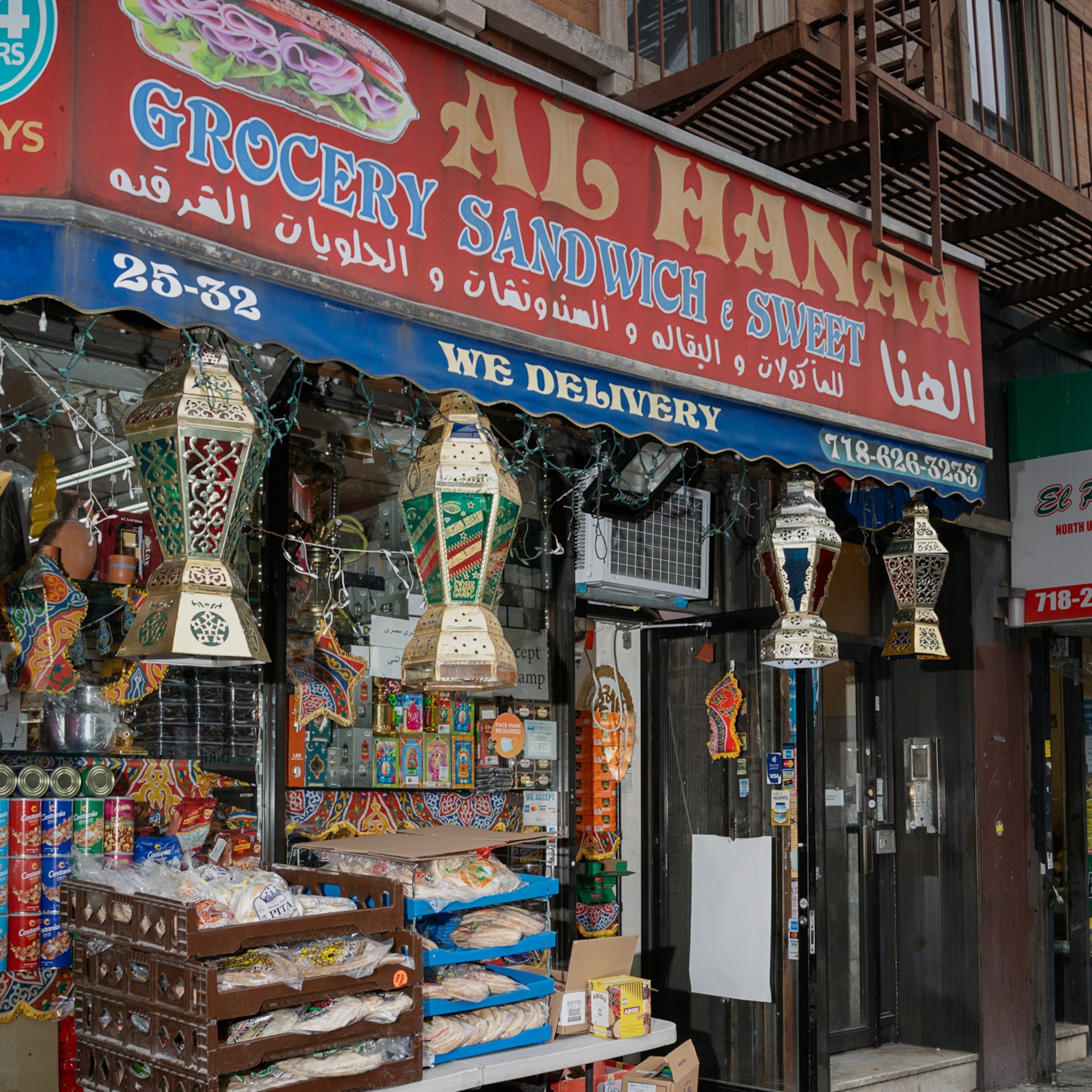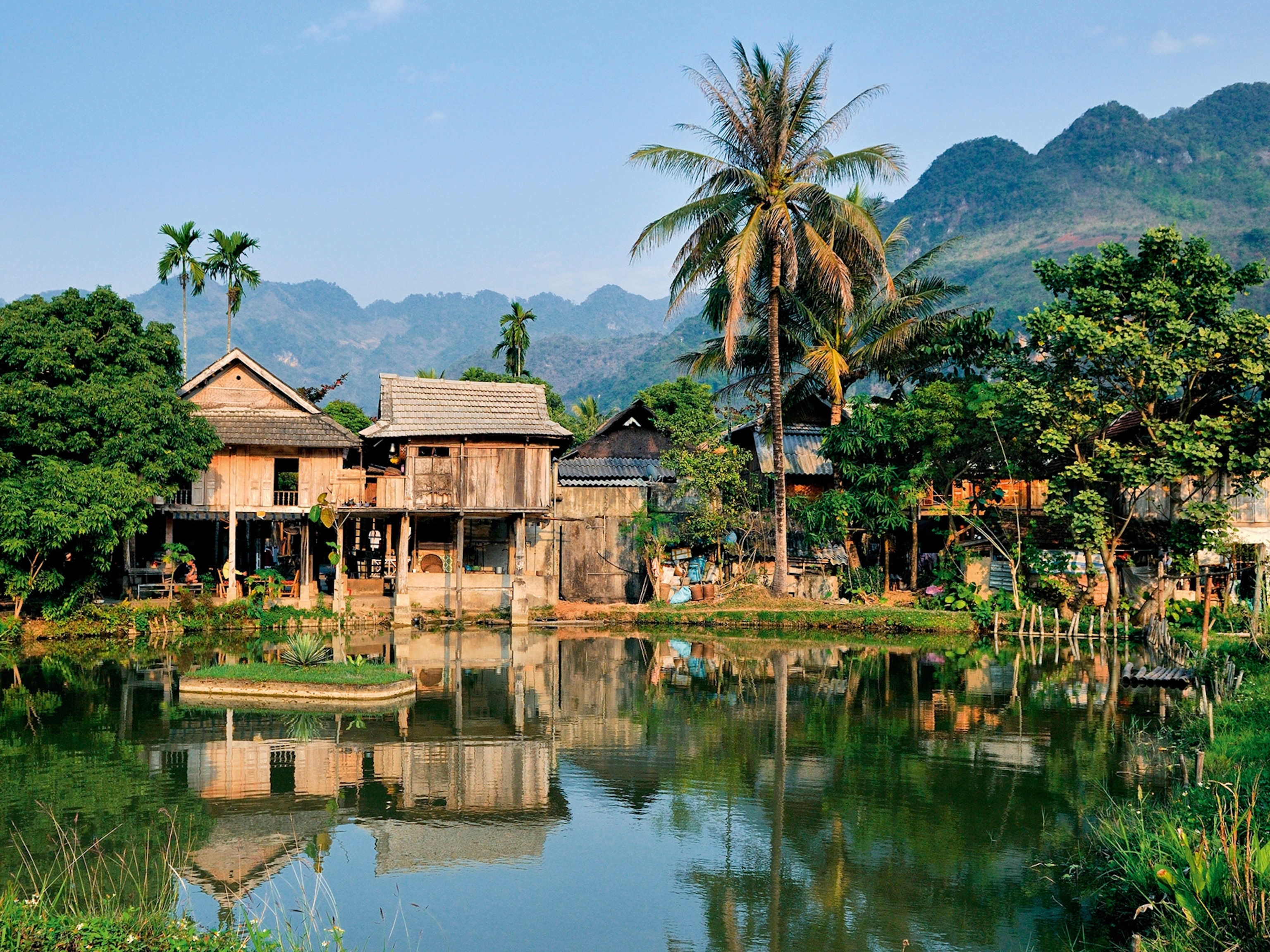
Hawaii’s Native language nearly vanished—this is the fight to bring it back
For a language to be considered safe from extinction, 100,000 people need to speak it. A small fraction of people speak ‘ōlelo today, but young Hawaiians using TikTok and Instagram may help change that.
E neʻeneʻe iki iho no ka heluhelu ʻana ma ka ʻōlelo Hawaiʻi.
On a crisp morning on the island of Oʻahu, fidgeting students at Pū‘ōhala Elementary gather on a field as lush mountains behind them peek out from the mist. Their day starts with chants in ‘ōlelo Hawai‘i, the islands’ Native language, reiterating values of respect and justice that their teachers hope will guide them through their education, and throughout their lives.
Like most kids their age, they’re not concerned with their grand legacy or the significance of the language they’re learning. Still, they have a weighty charge: to receive the torch and ensure the security of ‘ōlelo for future generations.
It was only 50 years ago that the language peered over the edge of extinction. Though the situation is much improved, in many ways ‘ōlelo is still on life support. Teachers say there’s a huge enthusiasm for school kids of all ethnicities to learn the language, but as they grow up, they’re encouraged to focus on “more useful” subjects and use English. In 2016, there were 18,610 Hawaiian speakers on the islands.
“One hundred thousand is the ballpark number of speakers needed to consider the language safe,” says N. Ha‘alilio Solomon, assistant professor of Hawaiian language at University of Hawaiʻi at Mānoa. “The idea is there are enough people transmitting it to the next generation, socializing their children to use the language in all domains of life, to express all thoughts and needs and desires.”
The kids of Pū‘ōhala Elementary will inherit the work of the current young adults banishing stigmas around language use, expanding access to ‘ōlelo in part through TikTok and Instagram, and making the language a viable skill in adulthood. These youth, along with revivalists from previous generations, share their hopes for the future.
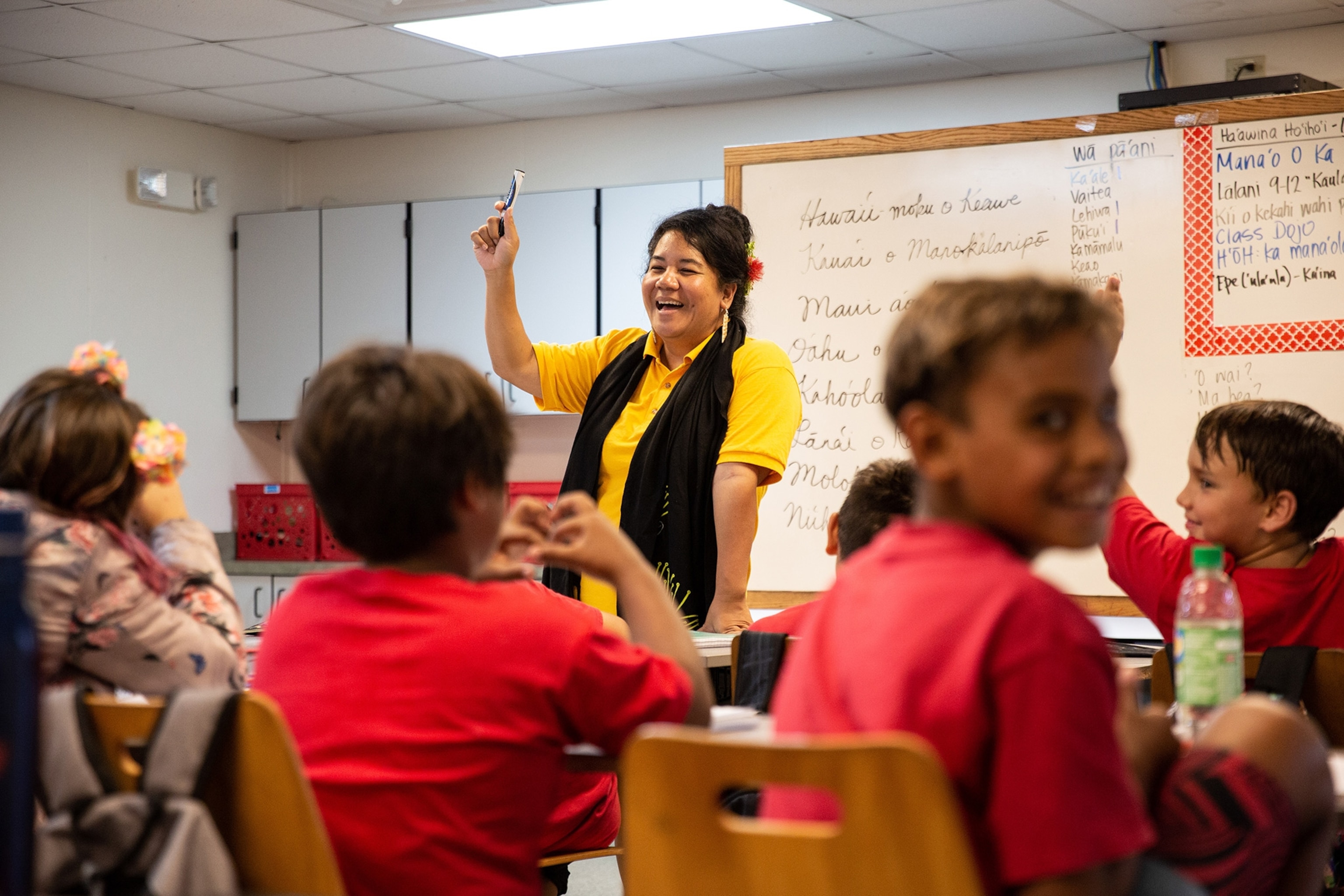
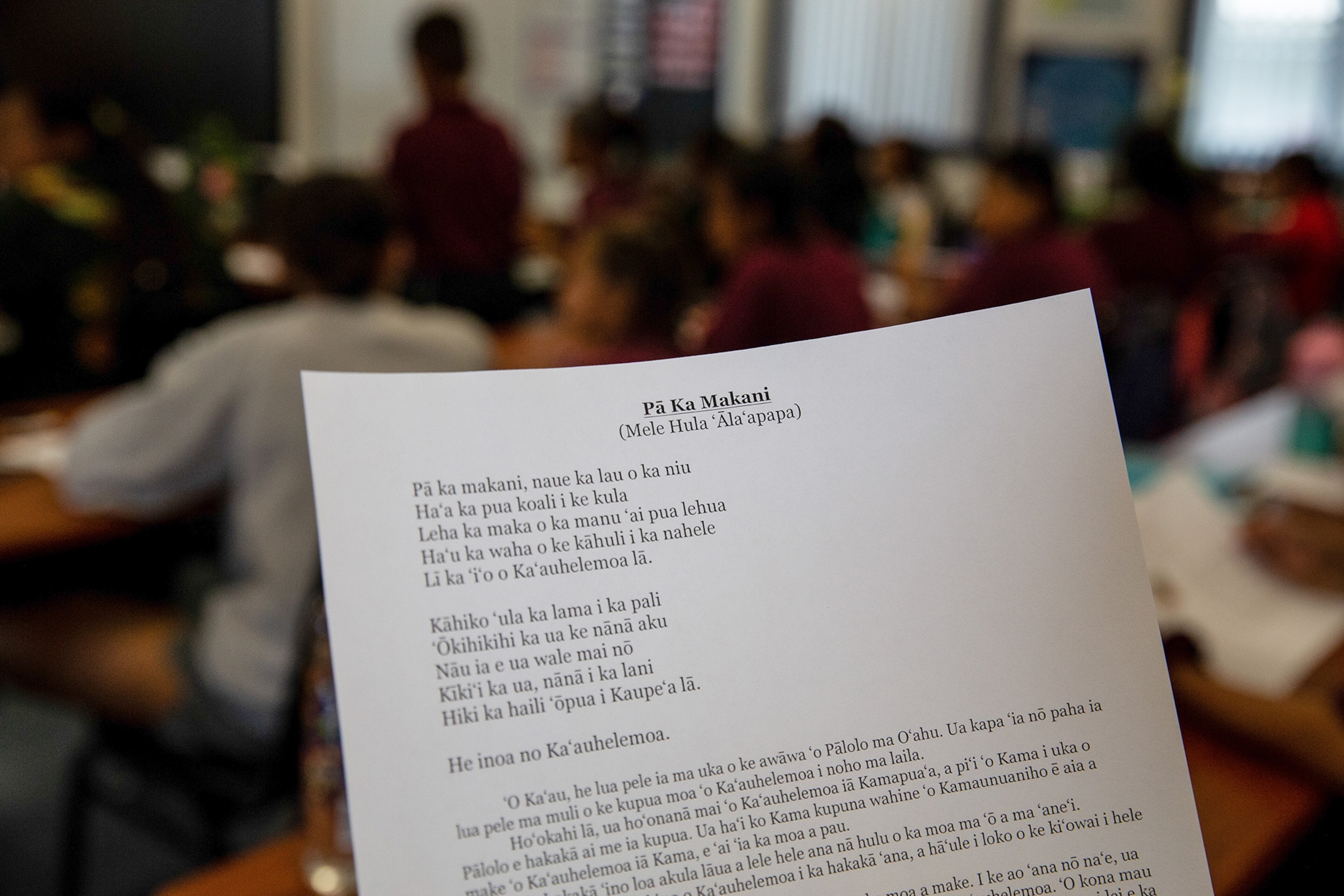
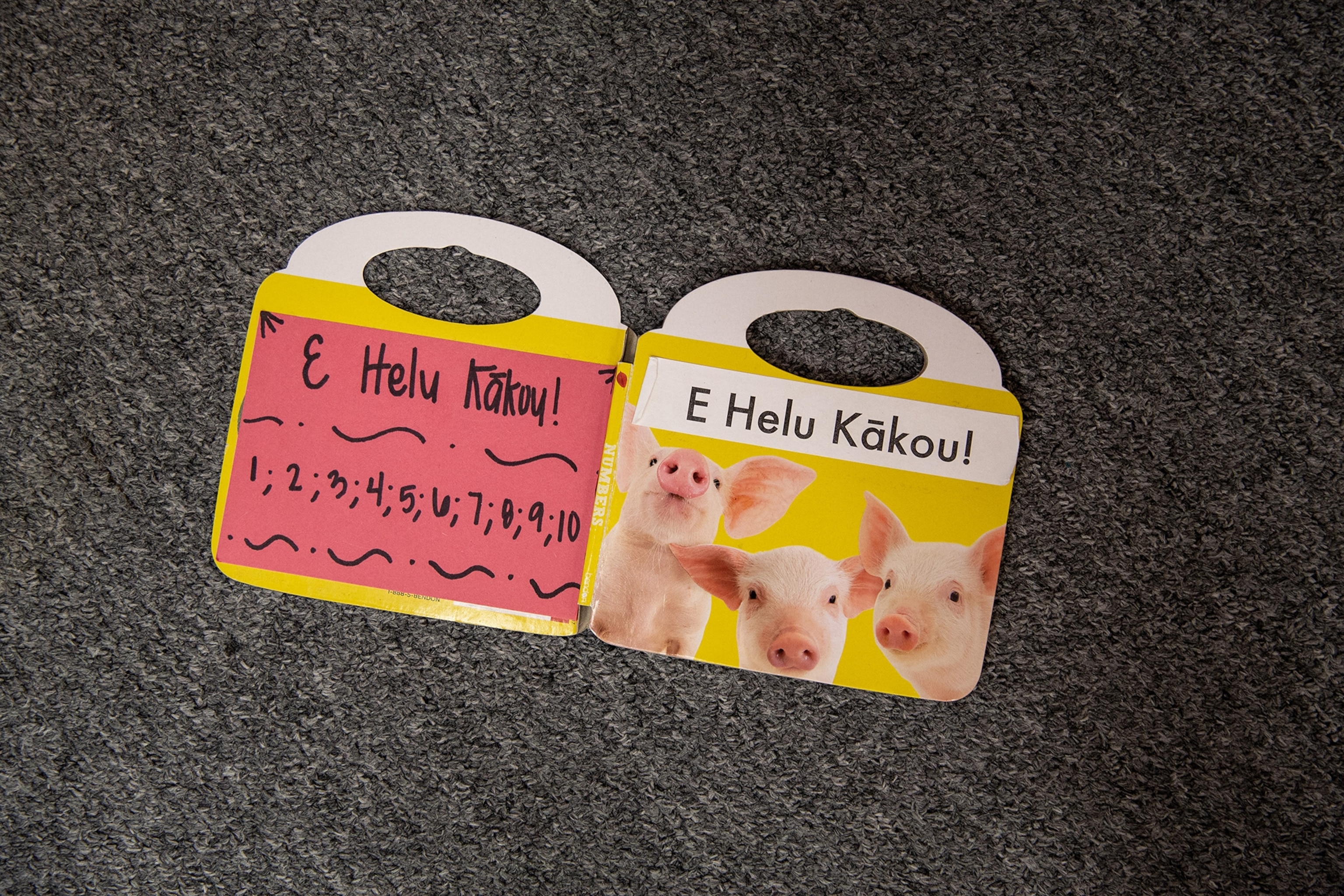
A brief history
By the end of the 19th century, literacy in Hawaii (in ‘ōlelo, spelled Hawai‘i) reached an astonishing high of over 90 percent. This was largely thanks to the public education system founded in 1840 by King Kamehameha III, the third king of Hawai‘i (58 years before the American invasion and annexation). It was one of the highest literacy rates in the world at the time, and still an impressive figure. In 2020, data from the United States Department of Education showed that 54 percent of adults (age 16 to 74) lack literacy proficiency.
During this time, more than a hundred Hawaiian language newspapers (nūpepa) were published, reporting on news around the world, hosting written debate, and recording chants, proverbs, and legends people rightfully feared might be lost.
When the monarchy was overthrown in 1893, a law was enacted to make English the language of instruction in all schools. Though ‘ōlelo was not outlawed, kids were disciplined for speaking it in schools. Those kids were conditioned to believe it was shameful: long after they needed to, many adults spoke ‘ōlelo only in private and refused to teach their kids.
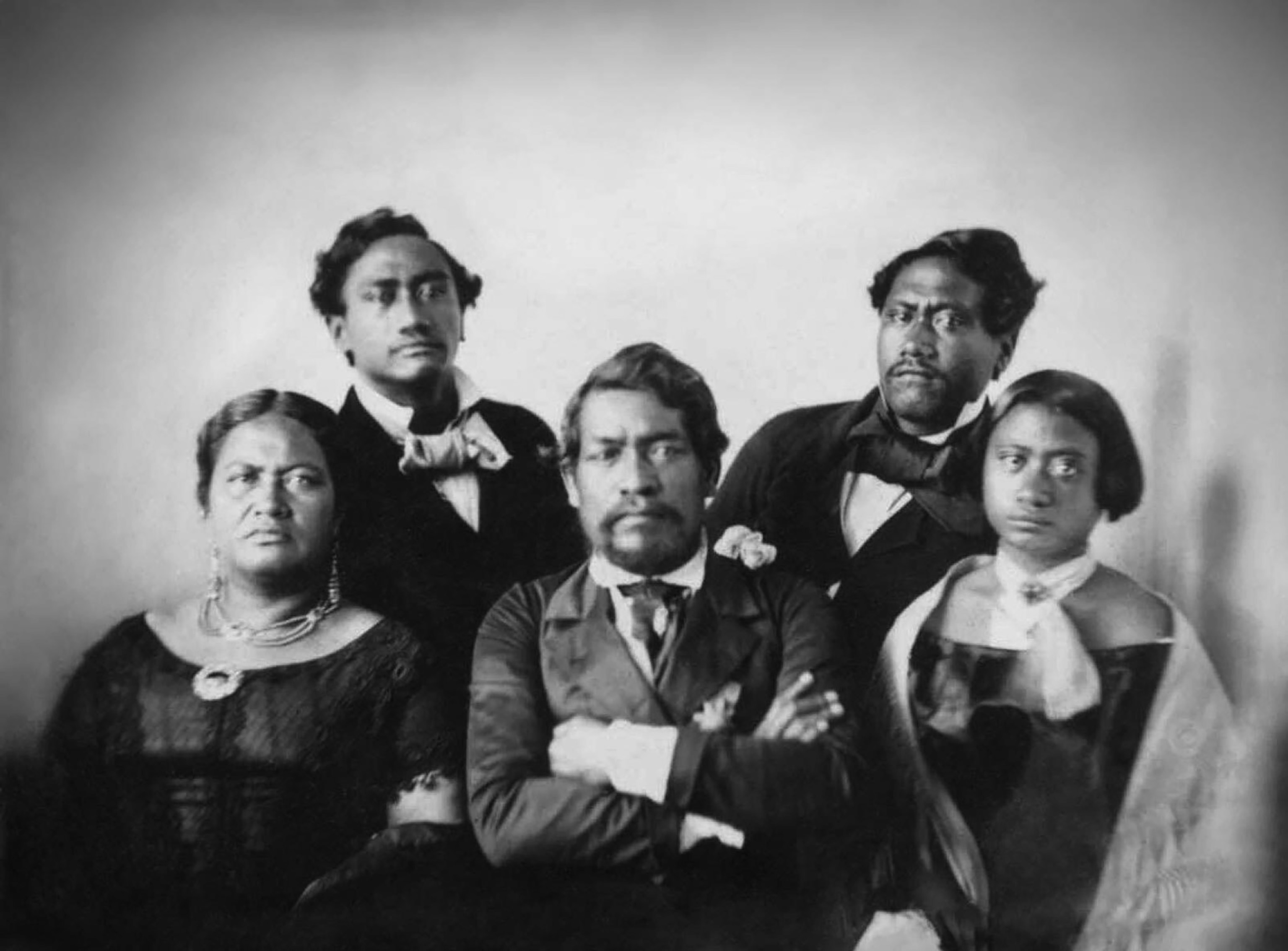
After almost a hundred years of suppression, Hawaiian youth led a renaissance of dance, music, and language in the 1970s. In 1978, ‘ōlelo was declared the state’s official language (along with English) and a law undoing the ‘ōlelo ban in schools was passed. Recordings were made of the very few Native speakers left, and nūpepa served an important role in restoring lost knowledge.
“There are stories of our elders being beaten for speaking Hawaiian,” says Kainani Kahaunaele, a celebrated Hawaiian language musician and teacher. “When we, in the Hawaiian Renaissance, were considering going to school to learn Hawaiian, it was something that was very traumatic for [the older generation]. It was like ‘Why are you going to school to learn Hawaiian? You have to learn English, Japanese… all these other things to become successful.’”
Immersion schools like Pū‘ōhala were established and Hawaiian studies became a standard offering in higher education. Hawai‘i has celebrated milestones including a new law bolstering Hawaiian language education, and the 10th year of Hawai‘i Language Month, where both public and private groups promote ‘ōlelo.
Advocates warn that the ghosts of the language ban still linger, and using Hawaiian into adulthood is still rare. Kids are often encouraged to learn “more useful” subjects in higher education. In grade schools, Hawaiian is still not required as English is, despite both being the state’s official languages.
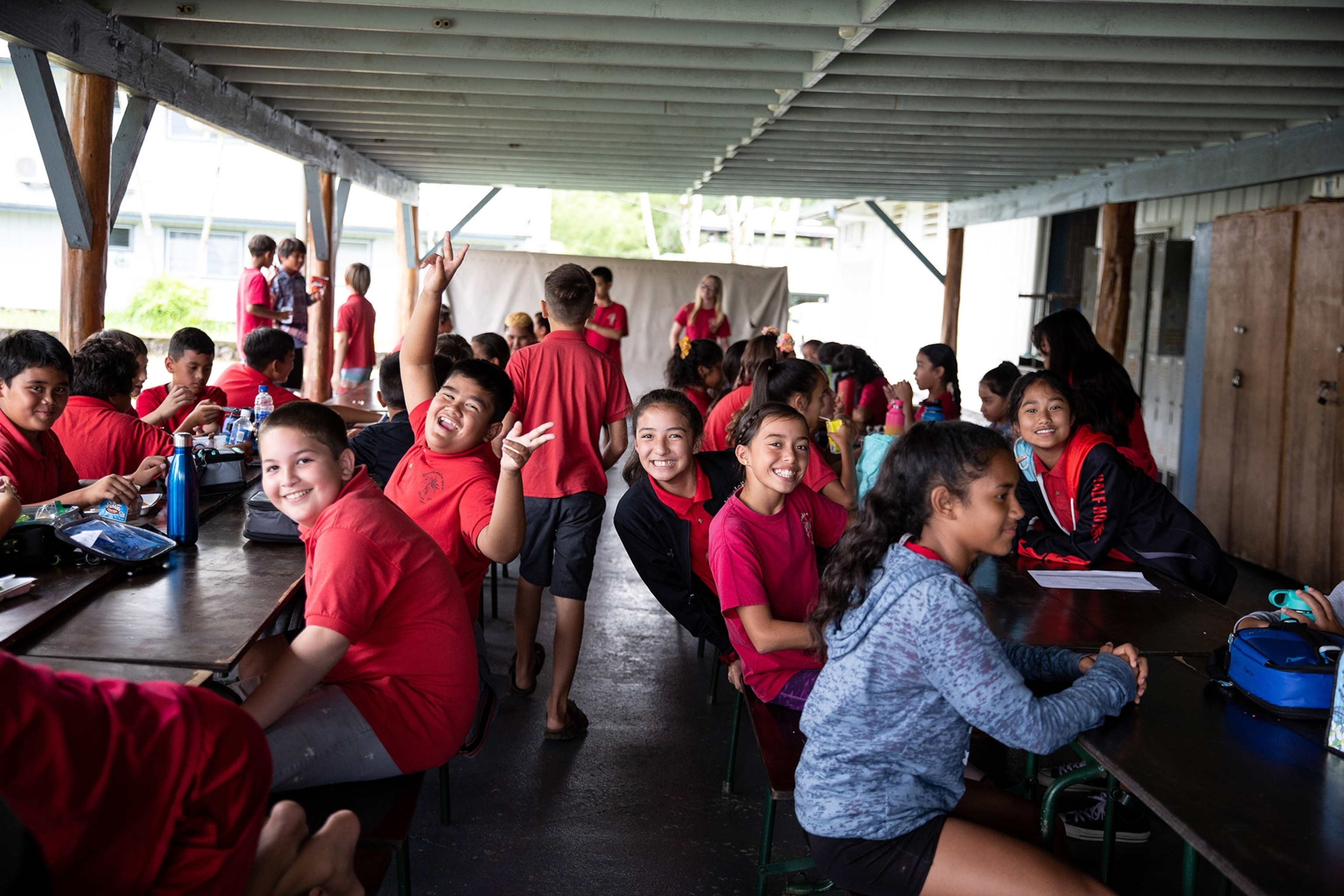
The fight continues
During recess recently, school children squealed gleefully as they ran past teacher Leimakamae Freitas, 22. In 2019, she represented Hawai‘i at the Miss Teen USA competition. Today, she teaches at a public charter school on the Big Island, where she runs an after-school Hawaiian enrichment program.
“I knew that I wanted to become a Hawaiian language teacher because… this is what I'm good at. I'm good at my language,” she says. “I'm good at my culture. I love being around it and immersed in it because it's like being in your element.”
During the pandemic, Freitas wanted to find a way to help her community. She started making Tiktoks on ‘ōlelo, from discussing sentence structure to pronouncing the Hawaiian islands, even clips offering mock conversation, amassing hundreds of thousands of views. She says she was overwhelmed by the responses, especially gratitude from people who said they always wanted to learn but didn’t have the opportunity.
Lily Okimura, 25, also took to Tiktok where she talks about local issues and snippets of her Hawaiian studies, including language. She says she was touched by messages from people saying their family had moved away from Hawai‘i generations ago, but her clips helped bring them close to their culture.
Her life changed in college when Okimura, an actress, learned there were plays in ‘ōlelo.
“It was definitely very different reading a Hawaiian play,” she says. “That was written by someone who was like me, and it reflects my community, and it reflects my life.”
Kapaia’ala Earle, 24, had a similar experience. He says “there was an awakening within me” once he realized in college that Hawaiian studies could offer a viable future. Now he works as a nūpepa archivist at the Bishop Museum.
“There’s a lot of self-fulfillment through this position,” Earle says. “We're doing something so powerful by digitizing these resources. I always think about what I'm doing now I'll be able to show my children in the future.”
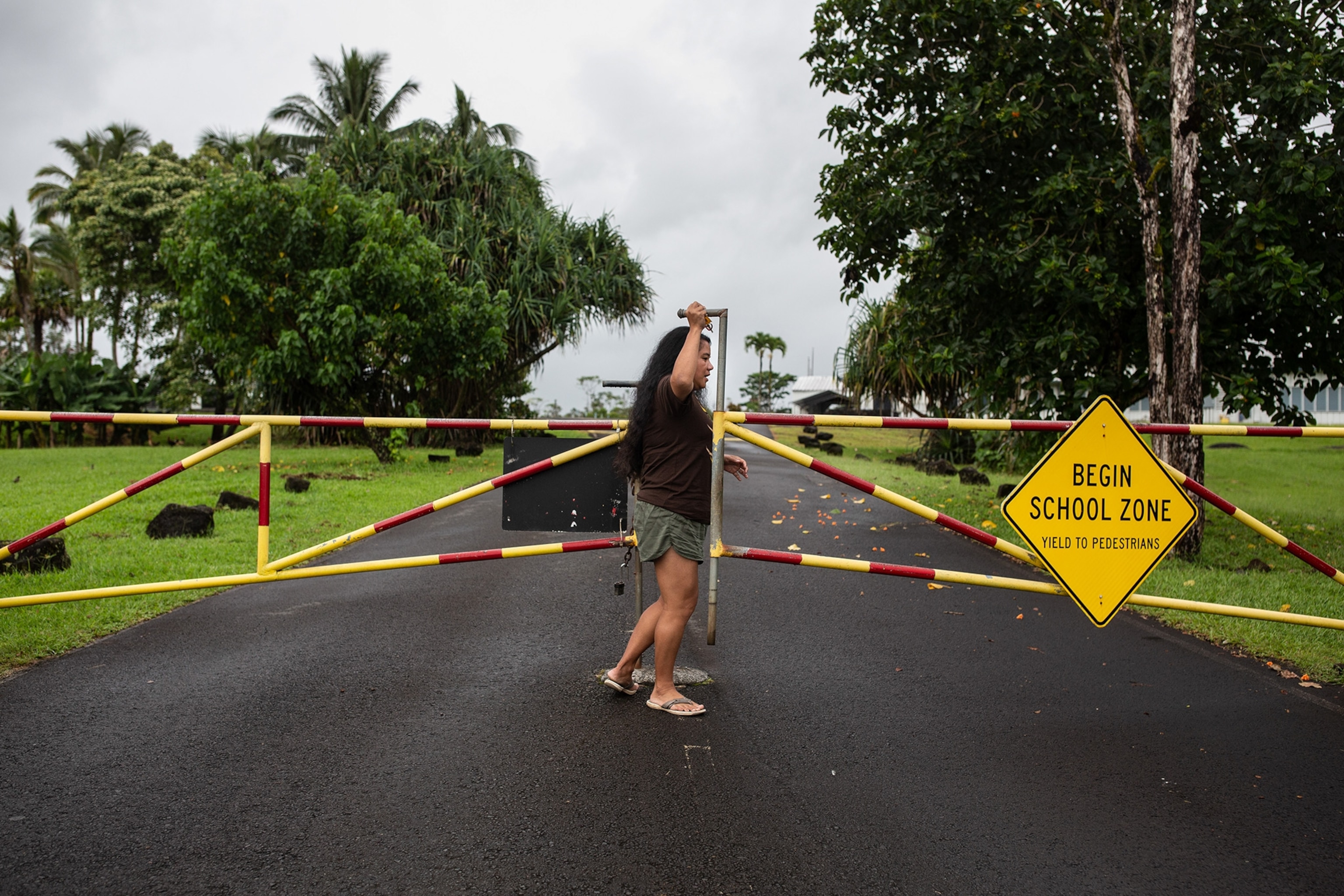
Dreams of a Hawaiian future
Many hotels along the Waikiki strip post bilingual signage. But few include ‘ōlelo—Japanese and Chinese are much more common. Some activists say it’s a self-perpetuating problem: catering to the most popular languages stifles the chance for ‘ōlelo to grow.
“It's always to the visitor coming in, rather than taking care of the people who live here,” says Ku‘uipo Kumukahi, a musician and director of the Ho‘okela Hawaiian heritage and culture center. She says ‘ōlelo should be seen and heard everywhere. “We should have signs, more than just street signs, it should be on the news. Our newscasters, they should be invested in that.”
Indigenous communities outside of Hawai‘i also are looking at how to protect their own languages. Solomon, the assistant professor of Hawaiian language, was recently in Winnipeg where he spoke with First Nations peoples about language revitalization, an issue he also is working on in Tahiti.
“A language is a dialogue with the environment… it captures the essence of that place where it developed better than imported languages. Being able to know these couple dozen words for different types of rain that Hawaiian has, that English doesn’t…that's something that's just, I think, really meaningful to be able to experience,” Solomon says. “It always gives you more. You see more colors in the spectrum. It's a richer experience.”
I ka ʻoluʻolu o ke ehu kakahiaka ma Oʻahu, ua ʻākoakoa nā haumāna pihaʻeu o ke Kula Kaiapuni ʻo Pūʻōhala ma ke kahua pāʻani, ma kumu pali hāuliuli o nā Koʻolau paʻa i ka noe. ʻO ka hana mua o ka lā kula, he oli ma ka ʻōlelo Hawaiʻi, ka ʻōlelo kupa o ka ʻāina, i paʻa ai iā lākou ia mau mea he aloha a he pono, kā nā kumu mea e hoʻoili nei ma luna o lākou i wahi e alakaʻi ana ma ko lākou ʻimi naʻauao, ma ka nohona kanaka hoʻi.
E like me ka hapa nui o nā kamaliʻi o ia makahiki, ʻaʻole paha lākou e manaʻo nui nei i ka hoʻoilina a ʻano nui paha o ka ʻōlelo a lākou e hoʻonaʻauao ʻia nei. Eia naʻe, he kaumaha nō ia kuleana a lākou e ʻauamo nei, ʻo ka mālama me ka hoʻopakele ʻana hoʻi i ia ʻōlelo no nā hanauna o mua aku.
He 50 wale nō makahiki i hala akula, ua ʻaneʻane ka ʻōlelo i ka nalowale pau loa. I loko nō o ka laha hou ʻana o ia ʻōlelo, ʻaʻole naʻe ia i kōnea loa mai. Wahi a ka poʻe kumu, he nui ka hoihoi o nā kamaliʻi kula o nā lāhui like ʻole i ke aʻo ʻana i ka ʻōlelo, a nui aʻe naʻe lākou, paipai ʻia nō e kau ka manaʻo ma ka ʻimi ʻike i “hiki ke hoʻohana ʻia” me ka ʻōlelo pū hoʻi i ka ʻōlelo Pelekane. I ka 2016, ua helu ʻia nā kānaka ʻōlelo Hawaiʻi he 18,610 ka heluna nui.
“He hoʻokahi haneli kaukani paha ka nui o ka poʻe e lawa ai ka hoʻokoe ʻia ʻana o ka ʻōlelo,” wahi a N. Haʻalilio Solomon, he hope polopeka ʻōlelo Hawaiʻi ma ke Kulanui o Hawaiʻi ma Mānoa. “ʻO ka pahuhopu, he lawa pono ka poʻe oʻo e ʻōlelo nei i ka poʻe ʻōpiopio, me ke aʻo ʻana i ke keiki e hoʻopuka i ia ʻōlelo ma nā wahi a pau o ka nohona kanaka, i hiki iā ia ke hōʻike pau i nā ʻano manaʻo, makemake, a mea aʻe paha e kupu nei ma loko ona.”
E ili mai ana ma luna o ko Pūʻōhala poʻe kamaliʻi he nohona kanaka kahi i kinai ʻia ai ka hilahila ma ka hoʻopuka ʻana i ka ʻōlelo Hawaiʻi, kahi i māhuahua aʻe ai ka ʻōlelo ʻia o ia ʻōlelo, ʻo TikTok me Instagram kekahi o ia mau wahi e laha aʻe nei ka ʻōlelo he mākaukau e waiwai ai no ka wā oʻo. Eia i ʻaneʻi kekahi mau ʻōpio, me kekahi o nā koa hoʻōla ʻōlelo o nā makahiki i hala, ke haʻi mai nei nō i ke ʻano e lana ai ko lākou manaʻo ma kēia mua aʻe.
A pau ke kenekulia ʻumikūmāiwa, ua piʻi aʻe ma luna o ke kanaiwa pākēneka ka ʻike palapala ma Hawaiʻi. ʻEʻole nā kula aupuni i hoʻokumu mua ʻia i ka 1840 e ka Mōʻī Kauikeaouli Kamehameha III, loaʻa ia naʻauao (he 58 makahiki ma mua aku o ka noho hewa ʻana o ʻAmelika me ka hoʻohui ʻāina kūʻai hewa). ʻO Hawaiʻi kekahi o nā lāhui nui loa o ka ʻike palapala a puni ka honua i ia wā, a hiki i kēia lā, he kupanaha ia heluna. I ka 2020, ua loaʻa i ke Keʻena Hoʻonaʻauao o ʻAmelika Huipūʻia ka ʻike helu e hōʻike ana, he 54 pākēneka o ka poʻe oʻo (ma ka 16 a ke 74 o ka makahiki), ua hemahema lākou i ka ʻike palapala.
I loko o ia wā, e paʻi ʻia ana nā nūpepa ʻōlelo Hawaiʻi he hoʻokahi haneli a ʻoi, kahi e kūkala ʻia ana ka nūhou kūloko me ko nā ʻāina ʻē, me ka hoʻopāpā aku a hoʻopāpā mai, a me ka hoʻopaʻa ʻana hoʻi i nā mele, ʻōlelo noʻeau, a moʻolelo kaʻao hoʻi a ka poʻe e makeʻe nui ana, o pau i ka nalowale.
I ka wā i kahuli ʻia ai ke aupuni mōʻī i ka 1893, ua kau aʻela he kānāwai e koi ana, ʻo ka Pelekane ka ʻōlelo o nā kula a pau. ʻAʻole nō i pāpā loa aʻela ke kānāwai, ʻaʻole e ʻōlelo Hawaiʻi, he hoʻopaʻi ʻia naʻe kekahi mau keiki ke hoʻopuka i ia ʻōlelo ma ke kula. ʻO ka laha koke aʻela nō ia o ka hilahila i ka ʻōlelo: ua ʻauheʻe ka poʻe mākua me ka hoʻopuka malū i ka ʻōlelo Hawaiʻi, me ka ʻōlelo ʻole hoʻi i ke keiki.
Ua ʻaneʻane ka hoʻokākāuha ʻia ʻana o ka ʻōlelo a hala nā makahiki he 100 makahiki, ua ala aʻela ma waena o ka poʻe Hawaiʻi he wā hoʻōla a hoʻokuluma hou no ka hula, ka mele, a me ka ʻōlelo i nā 1970. I ka 1978, ua holo ke kānāwai e hāpai aʻe ana i ka ʻōlelo Hawaiʻi (a me ka ʻōlelo Pelekane), he ʻōlelo kūhelu no ka mokuʻāina, a holo pū ke kānāwai i hoʻohuli i ka pāpā ʻia ʻana ʻaʻole e ʻōlelo Hawaiʻi ma ke kula. ʻO ka hoʻopaʻa ʻia akula nō o nā leo o ka poʻe ʻōlelo Hawaiʻi kumu e koe kākaʻikahi ana hoʻi, me ka lawelawe pū hou hoʻi i nā nūpepa i wahi e loaʻa hou ai ka ʻike i ʻaneʻane nalo aku.
“Lohe mau ʻia ka pepehi ʻia o kūpuna no ka hoʻopuka ʻana i ka ʻōlelo Hawaiʻi,” i pane ai ʻo Kainani Kahaunaele, he kumu ʻōlelo Hawaiʻi, haku mele, a mea hoʻokani pila hanohano hoʻi. “I ko mākou noʻonoʻo ʻana, i ka wā hoʻōla hou i nā loina Hawaiʻi, e ʻimi a ʻimi ʻole paha i ka naʻauao ma ka ʻōlelo Hawaiʻi, he wā ʻeha ia [no ka poʻe oʻo o ia wā]. Penei nō, ‘He aha nō lā hoʻi kāu ʻo ka ʻimi naʻauao ma ka ʻōlelo Hawaiʻi? E aho nō ʻoe e aʻo i ka Pelekane, Kepanī… ia mea aku ia mea aku hoʻi, ma laila kou pono.’”
Ua hoʻokumu ʻia nā kula kaiapuni, e laʻa ʻo Pūʻōhala, ua hoʻolako pū ʻia he mau papa ʻike Hawaiʻi ma nā pae kiʻekiʻe o ka ʻimi naʻauao. Ke hoʻomaikaʻi ʻia nei e ko Hawaiʻi he mau keʻehina holomua, e laʻa ke kānāwai hou e paipai ana i ka hoʻonaʻauao ʻōlelo Hawaiʻi, a me ka ʻumi o ka makahiki o ka Mahina ʻŌlelo Hawaiʻi, i wā e paipai ʻia ai ka ʻōlelo i ʻō a i ʻō.
ʻO ka poʻe paio mau no ka pono o ka ʻōlelo, he hopohopo lākou, ke oia mau nei nō nā ʻāweʻaweʻa hoʻohāmau ʻōlelo o ka pāpā ʻia o kānaka, ʻaʻole e ʻōlelo Hawaiʻi. Hopohopo pū i ka lawa a lawa ʻole o nā wahi e hoʻopuka ai i ka ʻōlelo. Hōʻeuʻeu ʻia mai kamaliʻi i ke aʻo i nā ʻike i “ʻoi aku o ka waiwai” ma nā pae kiʻekiʻe o ka ʻimi naʻauao. Ma loko o ke kula, ʻaʻole koi ʻia ka ʻōlelo Hawaiʻi, ʻo ka Pelekane naʻe, pēlā nō, i loko nō o ke ʻano kūhela o nā kūlana o nā ʻōlelo a ʻelua.
Paio like mau
I kekahi wā pāʻani iho nei, holo kamaliʻi me ka ʻuīʻuī o ka leo i ke alo o Kumu Leimakamae Freitas, he 22 ona makahiki. I ka 2019, ʻo ia ka meʻe no Hawaiʻi ma ka hoʻokūkū ʻo Miss Teen USA. I kēia mau lā, he kumu kula hoʻokumu ma Hawaiʻi mokupuni, kahi āna e mālama nei he papahana hoʻonui ʻike Hawaiʻi.
Ua ʻike au i koʻu makemake e lilo aku he kumu ʻōlelo Hawaiʻi no ka mea… ma laila koʻu huluaʻa. Akamai au i kaʻu ʻōlelo,” wahi āna. “Akamai au i koʻu mau loina. Mahalo nui au i kaʻu puni i nā loina Hawaiʻi no ka mea ma laila nō au e ʻeleu loa ai.
I ka wā o ka maʻi ahulau, ʻimi akula ʻo Freitas i wahi e kākoʻo ai ʻo ia i kona kaiāulu. ʻO kona hoʻolaha akula nō ia he mau wikiō ma ka Tiktok, mai ke kamaʻilio ʻana no ke anahulu a me ka puana ʻia ʻana o nā inoa mokupuni Hawaiʻi, pēlā me ka walaʻau ʻana ma ka ʻōlelo, a nui lehulehu ka poʻe i huli mai ko lākou maka e nānā. Pane maila ʻo ia he kupanaha ka nui o nā manaʻo i hoʻouna ʻia akula iā ia, he mahalo nō hoʻi na ka poʻe i hōʻike mai i ka lōʻihi o ko lākou ʻiʻini e aʻo i ka ʻōlelo, ʻaʻole naʻe i loaʻa iā lākou he ala.
Ma laila pū ʻo Lily Okimura, he 25 ona makahiki, ma Tiktok no ka walaʻau ʻana no nā pilikia kūloko a me kekahi mau kahina moʻolelo no kona ʻimi naʻauao ma ka ʻike Hawaiʻi. Ua pā kona naʻau i ka poʻe i hōʻike mai nei i ko lākou aloha me ka ʻōlelo pū, e kala loa ka haʻalele ʻana o ko lākou ʻohana iā Hawaiʻi nei, ma ka nānā ʻana i kāna mau wikiō i pili hou ai i ka ʻāina kulāiwi.
Ua loli nō kona nohona i kona wā ʻimi naʻauao ma ke kulanui, ʻoiai hoʻi ʻo Okimura, he mea hana keaka, e hoʻomaʻamaʻa ana i ka hana keaka ʻōlelo Hawaiʻi.
“He mea ʻokoʻa loa ka heluhelu ʻana i ka hana keaka ma ka ʻōlelo Hawaiʻi,” i pane ai ʻo ia. “He hana keaka i haku ʻia e ka mea i like kona ʻano me koʻu, he aka kona nohona e ʻike ʻia ai ʻo koʻu nohona.”
Ua like ka mea i ili ma luna o Kapaiaʻala Earle, he 24 ona makahiki. Pane ʻo ia, “ua hoʻāla hou ʻia au” i kona wā ma ke kulanui, a ʻike aku hoʻi ia, he waiwai ko ka ʻimi naʻauao ma ka ʻike Hawaiʻi. I kēia manawa he mālama waihona nūpepa kahiko ma ka Hale Hōʻikeʻike o Bihopa.
“Ma kēia ʻano hana, nui nā manawa e hoʻokō ai i ka makemake o loko iho,” i pane ai ʻo Earle. “He mana loa ka papahana a mākou e lawelawe nei ma ka hoʻokikohoʻe ʻana i kēia mau kumu ʻike. Kau mau koʻu manaʻo i kaʻu mea e hana nei, me ka hiki ke hōʻike aku i kaʻu poʻe keiki ma kēia mua aʻe.”
He hihiʻo Hawaiʻi no kēia mua aʻe
Nui nā hōkele ma Waikīkī kahi e waiho ana nā hōʻailona i paʻi ʻia ma nā ʻōlelo a ʻelua. He kākaʻikahi naʻe ka ʻōlelo Hawaiʻi––ʻo ke Kepanī me ka Pākē nā ʻōlelo maʻamau. Wahi a kekahi poʻe paio no ka pono, he pilikia ia e hoʻomau nei iā ia iho: ʻo ka mālama ʻana i nā ʻōlelo laha loa, he ʻoki ʻia o nā ala e māhuahua ai ka ʻōlelo.
I nā wā a pau, he mea no ka malihini e kipa mai nei, ʻaʻole hoʻi he mea e mālama ai i ka poʻe e noho nei ma ʻaneʻi,” wahi a Kuʻuipo Kumukahi, he mea hoʻokani pila a poʻo alakaʻi hoʻi no ka Hoʻokela Hawaiian heritage and culture center. Wahi āna, ma ʻō a ma ʻaneʻi e ʻike a e lohe ʻia ai hoʻi ka ʻōlelo. “Ua nele mākou i nā hōʻailona, ʻaʻole ʻo nā hōʻailona kuhikuhi alanui wale nō, e lohe pū ʻia ma ka nūhou. ʻO ko kākou poʻe kūkala nūhou, he pono ke kuleana ʻia lākou ma laila.”
He ʻimi aku nō nā kaiāulu ma waho aʻe o Hawaiʻi i wahi e hoʻomalu ai i kā lākou mau ʻōlelo iho. Ua huakaʻi aku nei ʻo Solomon, hope polopeka ʻōlelo Hawaiʻi, i Winnipeg, kahi āna i kamaʻilio pū ai me kekahi o nā lāhui First Nations no ka hoʻōla hou i ka ʻōlelo, ʻo ia kahi mea āna e kaulona nei no nā ʻōlelo kupa o Tahiti me ona mau pae ʻāina.
“ʻO ka ʻōlelo, he mea e pili pū ai me ka ʻāina… ʻo ka ʻōlelo ka mauli o ia ʻāina, ʻo ia ka ʻōlelo i kohu pono i ia wahi ma mua aʻe o nā ʻōlelo i lawe ʻia mai no waho mai. ʻO ka hiki ke hoʻomaopopo i nā huaʻōlelo he nui no ka mea hoʻokahi, e laʻa ka ua, ma ka ʻōlelo Hawaiʻi, i liʻiliʻi paha kona mau wehewehena ma ka Pelekane… ma laila ka waiwai loa. He mea hoʻi e ʻoi mau aʻe ai ka ʻike a ka maka, e pau ʻole ai hoʻi ka nani o ke ao nei.”

